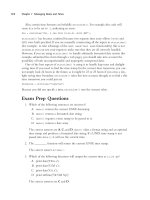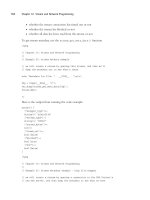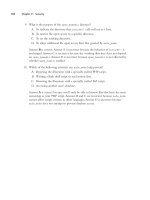Tài liệu Zend PHP Certification Study Guide- P6 ppt
Bạn đang xem bản rút gọn của tài liệu. Xem và tải ngay bản đầy đủ của tài liệu tại đây (121.98 KB, 20 trang )
84
Chapter 4 Arrays
<?php
$a = array (‘a’ => 10, 20, 30, 40);
$b = array (‘a’ => 20, 20, 30, 40);
$array = array_merge_recursive ($a, $b);
var_dump ($array);
?>
This results in the following array:
array(7) {
[“a”]=>
array(2) {
[0]=>
int(10)
[1]=>
int(20)
}
[0]=>
int(20)
[1]=>
int(30)
[2]=>
int(40)
[3]=>
int(20)
[4]=>
int(30)
[5]=>
int(40)
}
In this case, $a[‘a’] and $b[‘a’] are combined together into the $array[‘a’] array.
Intersection and Difference
If you want to extract all the elements that are common to two or more arrays, you can
use the array_intersect():
<?php
$a = array (‘a’ => 20, 36, 40);
$b = array (‘b’ => 20, 30, 40);
05 7090 ch04 7/16/04 8:43 AM Page 84
Please purchase PDF Split-Merge on www.verypdf.com to remove this watermark.
85
Serializing Arrays
$array = array_intersect ($a, $b);
var_dump ($array);
?>
Here’s the output:
array(2) {
[“a”]=>
int(20)
[1]=>
int(40)
}
As you can see, this function only checks whether the values are the same—the keys are
ignored (although the key of the leftmost array is preserved). If you want to include
them in the check, you should use array_intersect_assoc() instead:
<?php
$a = array (‘a’ => 20, 36, 40);
$b = array (‘b’ => 20, 30, 40);
$array = array_intersect_assoc ($a, $b);
var_dump ($array);
?>
In this case, the result will be a one-element array because the two 20 values in $a and
$b have different keys:
array(1) {
[1]=>
int(40)
}
If you want to calculate the difference between two or more arrays—that is, elements
that only appear in one of the arrays but not in any of the others—you will need to use
either array_diff() or array_diff_assoc() instead.
Serializing Arrays
Given their flexibility, arrays are often used to store all sorts of information, and it is
handy to be able to save their contents at the end of a script and retrieve them later on.
This is done through a process, known as “serialization,” in which the contents of an
array are rendered in a format that can later be used to rebuild the array in memory.
05 7090 ch04 7/16/04 8:43 AM Page 85
Please purchase PDF Split-Merge on www.verypdf.com to remove this watermark.
86
Chapter 4 Arrays
In PHP, serialization is taken care of by two functions:
n
serialize() renders the array in a format that can be safely saved to any contain-
er (such as a database field or a file) capable of handling textual content.
n
unserialize() takes a serialized input and rebuilds the array in memory.
Using these two functions is very easy:
<?php
$a = array (‘a’ => 20, 36, 40);
$saved = serialize ($a);
// Your script may stop here if you save the contents
// of $saved in a file or database field
$restored = unserialize ($saved);
?>
The serialization functionality is very flexible and will be able to save everything that is
stored in your array—except, of course, for resource variables, which will have to be re-
created when the array is unserialized.
Exam Prep Questions
1. Which of the following types can be used as an array key? (Select three.)
A. Integer
B. Floating-point
C. Array
D. Object
E. Boolean
Answers A, B, and E are correct.A Boolean value will be converted to either 0 if
it is false or 1 if it is true, whereas a floating-point value will be truncated to its
integer equivalent. Arrays and objects, however, cannot be used under any circum-
stance.
05 7090 ch04 7/16/04 8:43 AM Page 86
Please purchase PDF Split-Merge on www.verypdf.com to remove this watermark.
87
Exam Prep Questions
2. Which of the following functions can be used to sort an array by its keys in
descending order?
A. sort
B. rsort
C. ksort
D. krsort
E. reverse_sort
D is correct.The sort() and rsort() functions operate on values, whereas
ksort() sorts in ascending order and reverse_sort() is not a PHP function.
3. What will the following script output?
<?php
$a = array (‘a’ => 20, 1 => 36, 40);
array_rand ($a);
echo $a[0];
?>
A. A random value from $a
B. ‘a’
C. 20
D. 36
E. Nothing
Only E is correct.The $a array doesn’t have any element with a numeric key of
zero, and the array_rand() function does not change the keys of the array’s ele-
ments—only their order.
Questions of this type are in the exam not to trick you, but rather as a way to test your
ability to troubleshoot a problem. In this particular example, a developer who is well
versed in PHP recognizes the problem immediately, whereas a less experienced program-
mer will be sidetracked by thinking that something is wrong with the function being
called. After all, these kinds of bugs, usually caused by distraction or typos, are quite com-
mon in real-life code.
05 7090 ch04 7/16/04 8:43 AM Page 87
Please purchase PDF Split-Merge on www.verypdf.com to remove this watermark.
05 7090 ch04 7/16/04 8:43 AM Page 88
Please purchase PDF Split-Merge on www.verypdf.com to remove this watermark.
5
Strings and Regular Expressions
Terms You’ll Need to Understand
n
The == and === operators
n
Regular expression
n
PCRE
Techniques You’ll Need to Master
n
Formatting strings
n
Comparing strings
n
Modifying string contents
n
Using regular expressions for pattern matching and extraction.
n
Joining and splitting strings
The Web is largely a text-oriented environment. Data is submitted to websites in the
form of text strings, and the response (be it in HTML, XML, or even an image format)
is generally text as well. Accordingly, being able to analyze and manipulate text is a core
skill of any PHP programmer.
Comparing Strings
In this section, you will learn how to test whether two strings are equal, or whether one
string exists inside of another string.
06 7090 ch05 7/16/04 8:42 AM Page 89
Please purchase PDF Split-Merge on www.verypdf.com to remove this watermark.
90
Chapter 5 Strings and Regular Expressions
Comparison with == and ===
The most basic way of comparing any two entities in PHP is using the == operator
(called the is equal operator).When the == operator tests the equivalence of two entities,
it first reduces them to a common type.This often causes unexpected results. For exam-
ple, the following code outputs $a and $b are equal:
$a = ‘Hello World’;
$b = 0;
if($a == $b) {
print “\$a and \$b are equal\n”;
} else {
print “\$a and \$b are not equal\n”;
}
The reason this happens is that $a is a string type and $b is an integer, so the Zend
Engine needs to convert them to a common type for comparison. == is a weak operator,
so it converts to the more lenient type, namely integer.The integer representation of
‘Hello World’ is 0, so $a == $b is true. == should only be used to compare strings if
you are certain that both its operands are in fact strings.
PHP also provides the stronger equivalence operator === (called the is identical opera-
tor).Whereas the == was too weak to be useful in many situations, === is often too
strong. === performs no type-homogenization, and requires that both operands be of the
same type before a comparison can be successful.Thus, the following code outputs $a
and $b are not equal:
$a = 1;
$b = “1”;
if($a === $b) {
print “\$a and \$b are equal\n”;
} else {
print “\$a and \$b are not equal\n”;
}
This result occurs because $a is internally held as an integer, whereas $b, by virtue of its
being quoted, is a string.
Thus, === can be dangerous to use if you are not certain that both operands are
strings.
Tip
You can force a variable to be cast to strings by the use of casts. Thus,
if( (string) $a === (string) $b) { }
will convert both $a and $b to strings before performing the conversion. This produces the results you
expect, but is a bit clumsy—using the strcmp family of functions is generally preferred.
06 7090 ch05 7/16/04 8:42 AM Page 90
Please purchase PDF Split-Merge on www.verypdf.com to remove this watermark.
91
Comparing Strings
Using strcmp and Friends
The preferred way of comparing two entities as strings is to use the strcmp() function.
strcmp() takes two arguments and compares them lexigraphically (also known as diction-
ary ordering, as it is the same logic used in sorting words in a dictionary). strcmp()
returns 0 if the two strings are identical.Thus this code, which gave us trouble before,
will correctly output that $a and $b are the same:
$a = 1;
$b = “1”;
if(strcmp($a, $b) == 0) {
print “\$a and \$b are the same\n”;
} else {
print “\$a and \$b are different\n”;
}
If its two operands are not the same, strcmp() will return -1 if the first operand would
appear before the second in a dictionary, and 1 if the first operand would appear after
the second in a dictionary.This behavior makes it very useful for sorting arrays of words.
In fact, the following two bits of code will sort the array $colors in the same fashion
(in dictionary order):
$colors = array(“red”, “blue”, “green”);
sort($colors, SORT_STRING);
and
$colors = array(“red”, “blue”, “green”);
usort($colors, ‘strcmp’);
By itself, this is not very useful. (sort() should be preferred over usort() when per-
forming equivalent tasks), but strcmp() has some sibling functions that perform similar
tasks.
strcasecmp() is identical to strcmp() except that it performs comparisons that are
not case sensitive.This means that the following code that will output $a is the same as
HELLO, modulo case:
$a = ‘hello’;
if(strcasecmp($a, ‘HELLO’)) {
print “\$a is the same as HELLO, modulo case\n”;
}
Also, RED will come after blue when sorted via strcasecmp(), whereas with strcmp(),
RED will come before blue.
06 7090 ch05 7/16/04 8:42 AM Page 91
Please purchase PDF Split-Merge on www.verypdf.com to remove this watermark.
92
Chapter 5 Strings and Regular Expressions
Matching Portions of Strings
You’ve seen how to match strings exactly, but sometimes you only need to match a por-
tion of a string.When only a portion of a string is considered, it is referred to as a sub-
string. Specifically, a substring is any portion of a string. For example, PHP is a substring of
the string PHP is a scripting language.
Matching Leading Substrings
To match only the leading portion of strings, PHP provides the strncmp() family of
functions. strncmp() and strncasecmp() are identical to strcmp() and strcasecmp(),
but both take a third parameter, $n, that instructs PHP to compare only the first $n char-
acters of both strings.Thus strncmp(‘figure1.gif’, ‘figure2.gif’, 6) will return
0 (equal) because only the first six characters of each string is compared.
Matching Substrings at Arbitrary Offsets
If you need to determined simply whether a substring exists anywhere inside a given
string, you should use strstr(). strstr() takes as its first argument a string to be
searched (often called the subject), and as its second the substring to search for (often
called the search pattern). If strstr() succeeds, it will return the searched for substring
and all text following it; otherwise, it returns false.
Here is a use of strstr() to determine whether the word PHP appears in the string
$string:
if(strstr($string, ‘PHP’) !== FALSE) {
// do something
}
If you want to search for a substring irrespective of case, you can use stristr(). Here is
a check to see if any forms of ‘PHP’ (including ‘php’, ‘Php’, and so on) appear in
$string:
if(stristr($string, ‘PHP’) !== FALSE) {
// do something
}
If instead of the actual string you would like the position of the match returned to
you, you can use strpos(). strpos() works similarly to strstr(), with two major
differences:
n
Instead of returning the substring containing the match, strpos() returns the
character offset of the start of the match.
n
strpos() accepts an optional third parameter that allows you to start looking at a
particular offset.
Here is a sample usage of strpos() to find every starting position of the substring ‘PHP’
in a search subject $string.
06 7090 ch05 7/16/04 8:42 AM Page 92
Please purchase PDF Split-Merge on www.verypdf.com to remove this watermark.
93
Formatting Strings
$offset = 0;
$match_pos = array();
while(($offset = strpos($string, ‘PHP’, $offset)) !== FALSE) {
$match_pos[] = $offset;
}
strpos() also has a not case-sensitive form, stripos(), that behaves in a similar fashion.
Tip
Because the first character in a string is at position 0, you should always use === to test whether a match
from strpos() succeeded or failed.
If you need to match from the end of your subject backwards, you can do so with
strchr(), strrpos(), or strripos(). strrpos() and strripos() behave identically to
strpos() and stripos() with the exception that they start at the end of the subject
string and that the search pattern can only be a single character. strrchr() behaves like
strstr(), returning the matched character and the rest of the subject following it, but it
also requires a single character search pattern and operates starting at the end of the sub-
ject (this is in contrast with the majority of strr* functions, which take full strings for
all their arguments).
Formatting Strings
Specifying specific formats for strings is largely a leftover from compiled languages such
as C, where string interpolation and static typing make it more difficult to take a collec-
tion of variables and assemble them into a string. For the most part, PHP will do all of
this for you. For example, most string formatting looks like this:
$name = ‘George’;
$age = 30;
print “$name is $age years old.”;
When variables are placed inside a double-quoted string, they are automatically expand-
ed. PHP knows how to convert numbers into strings as well, so $age is correctly
expanded as well.
Occasionally, however, you need to perform more complex formatting.This includes
the padding of numbers with 0s (for example, displaying
05 instead of 5), limiting the
printed precision of floating point numbers, forcing right-justification, or limiting the
number of characters printed in a particular string.
printf Formats
The basic function for formatting is printf(). printf() takes a format string and a list
of arguments. It then passes through the formatting string, substituting special tokens
contained therein with the correctly formatted arguments.
06 7090 ch05 7/16/04 8:42 AM Page 93
Please purchase PDF Split-Merge on www.verypdf.com to remove this watermark.
94
Chapter 5 Strings and Regular Expressions
Formatting tokens are denoted with a %. In their simplest form, this is followed
directly by a type specifier from Table 5.1.
Table 5.1 printf() Format Specifiers
Specifier Format
b The argument is treated as an integer and is presented as an integer in binary
form.
c The argument is treated as an integer and is presented as the ASCII character
for that value.
d The argument is treated as an integer and presented as a signed integer.
u The argument is treated as an integer and presented as an unsigned integer.
f The argument is treated as a floating-point number and presented as a float-
ing-point number.
o The argument is treated as an integer and presented as its octal representation.
x The argument is treated as an integer and presented as a hexadecimal number
(using lowercase letters).
X The argument is treated as an integer and presented as a hexadecimal number
(using uppercase letters).
Thus, the preceding simple code block that prints $name and $age can be rewritten as
follows:
printf(“%s is %d years old”, $name, $age);
By itself, this is not terribly useful.Though it might be slightly more readable than using
interpolated variables (especially to people coming from a C or Java background), it is
also slower and not more flexible.
The usefulness of the formatting functions comes via the format modifiers that can
be added between the % and the format specifier, from right to left:
n
A floating-point precision, given by a . followed by the desired precision that says
how many decimal places should be displayed for a floating point number. Note
that this will round numbers to the specified precision.
n
A field width that dictates how many characters minimum should be displayed for
this token. For example, to guarantee that at least eight characters are allotted for
an integer, you would use the format specifier “%8d”. By default, blank spaces are
used to pad the results.
n
To left-justify a formatting, a - can be added to the format.
n
Instead of using blank spaces, an expansion can be padded with 0s by preceding
the width-specifier with a 0.Thus, if you are printing time in 24-hour notation
(such that one o’clock is printed as 01:00), you can use the following:
printf(“%02d:%02d”, $hour, $minute);
06 7090 ch05 7/16/04 8:42 AM Page 94
Please purchase PDF Split-Merge on www.verypdf.com to remove this watermark.
95
Extracting Data from Strings
Optionally, a different character can be specified by escaping it with a ‘. So to pad all
your numbers with xxx, you would use
printf(“%’xd”, $number);
printf() Family Functions
PHP has a small collection of formatting functions that are differentiated from each
other by how they take their arguments and how they handle their results.
The basic function (which you saw previously) is printf(). printf() takes a format
string and a variable number of arguments that it uses to fill out the format string. It
outputs the result.
fprintf() is identical to printf(), except that instead of writing output to the stan-
dard display stream, it writes output to an arbitrary stream resource specified as the first
parameter.
sprintf() is identical to printf(), but instead of outputting its results, it returns
them as a string.
vprintf() takes its arguments as a single array (instead of a variable number of indi-
vidual arguments) and outputs the result.This is useful when you are passed a variable
number of arguments—for example, via call_user_func_array() or
func_get_args().
vsprintf() is identical to vprintf(), except that instead of outputting its result, it
returns it as a string.
Table 5.2 is a complete listing of all the formatting functions, with a list of the args
they take and where their result is sent (as output, to an arbitrary stream, or to a string).
Table 5.2 Formatting Functions
Function Args Result
printf format, args writes output
sprintf format, args returns result
vprintf format, array of args writes output
vsprintf format, array of args returns result
fprintf stream resource, writes output to
format, args stream
Extracting Data from Strings
When dealing with data that comes in from an external source (for example, read from a
file or submitted via a form), complex data is often packed into strings and needs to be
extracted. Common examples include decomposing phone numbers, credit card num-
bers, and email addresses into their base components. PHP provides both basic string
functions for efficiently extracting data in fixed formats, as well as regular expression
facilities for matching more complex data.
06 7090 ch05 7/16/04 8:42 AM Page 95
Please purchase PDF Split-Merge on www.verypdf.com to remove this watermark.
96
Chapter 5 Strings and Regular Expressions
Extracting Substrings by Offset
To extract a substring by offset, you can use the substr() function. substr() works by
taking a string (the subject), an offset from the beginning of the string from which to
start, and an optional length (by default, the remainder of the string from which the start
offset is grabbed).
For example, to get all of $string except for the first character, you can use the
following:
$result = substr($string, 1);
or to grab the first eight characters of a string, you can use this code:
$result = substr($string, 0, 8);
For a more nontrivial example, consider this code that grabs the local part of an email
address (the part before the @ character) by using strpos() to find the @ symbol and
substr() to extract the substring preceding it:
$local_part = substr($email, 0, strpos($email, ‘@’));
If you need to grab a substring at the end of your subject, you can use a negative offset
to indicate that your match is relative to the end of a string. For example, to grab the last
four characters of a string, you can do the following:
$result = substr($email, -4);
If you need to only access individual characters in a string, you can use curly braces ({})
to access the string’s characters by offsets. For example, to iterate over every character in
a string and capitalize the odd numbered characters, you can do the following:
$len = strlen($string);
for($i = 0; $i < $len; $i++) {
if($i % 2) {
$string{$i} = strtoupper($string{$i});
}
}
Extracting Formatted Data
Real-world data extraction tasks often involve strings that have vague formats. Complex
data extraction usually requires the use of regular expressions (covered later in this chap-
ter), but if the data is of a format that can be specified with a printf() formatting
string, you can use sscanf() to extract the data.
For example, to match IP address/port number pairings of the form
127.0.0.1:6137, you can use the format “%d.%d.%d.%d:%d”.That can be used with
sscanf() as follows:
$parts = sscanf($string, “%d.%d.%d.%d:%d”);
06 7090 ch05 7/16/04 8:42 AM Page 96
Please purchase PDF Split-Merge on www.verypdf.com to remove this watermark.
97
Modifying Strings
If $string is 127.0.0.1:6137, $parts will be filled out thusly:
Array
(
[0] => 127
[1] => 0
[2] => 0
[3] => 1
[4] => 6137
)
Though flexible, sscanf() parsing is a bit fragile:The pattern must match exactly (mod-
ulo whitespace) at the beginning of the subject string.
Modifying Strings
In this section, you will see how to modify strings by replacing substrings, both by the
offset of where you want to perform the replacement and by simple pattern match (for
example, replacing all occurrences of ‘foo’ with ‘bar’).
Modifying Substrings by Offset
To replace a substring in a subject string, you can use the substr_replace() function.
substr_replace()’s first argument is a subject string; its second a replacement string; its
third the offset to start the replacement at; and its optional fourth argument is the length
of the subject substring to replace.
To illustrate this, consider how to X out all but the last four digits of a credit card
number. Here is code to perform this with substr_replace():
$len = strlen($ccnum);
$newnum = substr_replace($ccnum, str_repeat(‘X’, $len -4), 0, $len - 4);
First, you find the length of the credit card number in question, and then you replace the
first $len - 4 characters with an equal number of X’s.
Replacing Substrings
Another common string modification task is replacing all occurrences of one substring
with another.The preferred function for doing this is str_replace(). str_replace()
takes as its first argument a string to be matched, and as its second the string to substitute
in. Its third parameter is the subject on which all this replacement should occur. For
example, to replace all occurrences of :) with the image link <img
, you can use the following replacement:
$new_subject = str_replace(‘:)’, ‘<img src=”/smiley.png”/>’, $subject);
06 7090 ch05 7/16/04 8:42 AM Page 97
Please purchase PDF Split-Merge on www.verypdf.com to remove this watermark.
98
Chapter 5 Strings and Regular Expressions
Of course, you often need to do not case-sensitive substitutions. For example, if you
need to reverse the action of nl2br() and replace all HTML <br> line breaks with
newlines, you need to match <br> not case sensitively. str_ireplace() supplies this
semantic, enabling the search strings to be matched irrespective of case. Here is a func-
tion br2nl() illustrating that:
function br2nl($subject)
{
return str_ireplace(“<br>”, “\n”, $subject);
}
Both str_replace() and str_ireplace() also accept arrays for all their parameters.
When arrays are passed for the pattern and replacement, all the replacements are execut-
ed with that one call. If an array of subjects is passed, the indicated replacements will be
performed on each in turn. Here you can see this array functionality used to substitute a
couple of emoticons in one pass:
$emoticons = array( ‘:)’ => ‘<img ‘;)’ => ‘<img src=”/wink.png”/>’,
‘:(‘ => ‘<img src=”/frown.png”/>’);
$new_subject = str_replace(array_keys($emoticons),
array_values($emoticons), $subject);
Regular Expressions
The most powerful tools in the string manipulation toolbox are regular expressions
(often abbreviated regexps). Regular expressions provide a robust language for specifying
patterns in strings and extracting or replacing identified portions of text.
Regular expressions in PHP come in two flavors: PCRE and POSIX. PCRE regular
expressions are so named because they use the Perl Compatible Regular Expression
library to provide regexps with the same syntax and semantics as those in Perl. POSIX
regular expressions support standard POSIX-extended regular expression syntax.The
POSIX regular expression functions (the ereg_ family of functions and split()) are
slower than their PCRE equivalents, not-binary safe, less flexible, and in general their use
is discouraged in favor of the PCRE functions.
Basic PCRE Syntax
A regular expression pattern is a string consisting of plain text and pattern metacharac-
ters.The regexp metacharacters define the type and number of characters that can match
a particular part of a pattern.
The most basic set of metacharacters are the character classes, which allow a pattern
to match multiple characters simultaneously.The basic character classes are shown in
Table 5.3.
06 7090 ch05 7/16/04 8:42 AM Page 98
Please purchase PDF Split-Merge on www.verypdf.com to remove this watermark.
99
Regular Expressions
Table 5.3 PCRE Base Character Classes
Metacharacter Characters Matched
\d Digits 0–9
\D Anything not a digit
\w Any alphanumeric character or an underscore (_)
\W Anything not an alphanumeric character or an underscore
\s Any whitespace (spaces, tabs, newlines)
\S Any nonwhitespace character
. Any character except for a newline
The basic character class metacharacters each match a single character.Thus, to make
them useful in patterns, you need to be able to specify how many times they must
match.To do this, PCRE supports enumeration operators.The enumeration operators
are shown in Table 5.4.
Table 5.4 PCRE Enumerators
Operator Meaning
? Occurs 0 or 1 time
* Occurs 0 or more times
+ Occurs 1 or more times
{,n} Occurs at most n times
{m,} Occurs m or more times
{m,n} Occurs between m and n times
Putting these together, you can form basic patterns such as, ‘matches a US ZIP+4’:
\d{5}-\d{4}. Notice that the - character is in the pattern. If a nonmetacharacter appears
in the pattern, it must be matched exactly.
To test to see if a string $subject matches this pattern, you use preg_match() as
follows:
if(preg_match(“/\d{5}-\d{4}/”, $subject)) {
// matches a ZIP+4
}
preg_match()’s first argument is the pattern, and the second argument is the subject
string. Notice that the pattern itself is enclosed in forward slashes. PCRE supports arbi-
trary delimiters for patterns, but be aware that the delimiter character must be escaped
within the pattern.
Unlike sscanf() format matches, a preg_match() will match anywhere it can in the
subject string. If you want to specify that the pattern must start matching immediately at
the beginning of the subject, you should use the positional anchor ^.You can also match
06 7090 ch05 7/16/04 8:42 AM Page 99
Please purchase PDF Split-Merge on www.verypdf.com to remove this watermark.
100
Chapter 5 Strings and Regular Expressions
the end of a string with the positional anchor $.Thus, to match a string only if it is
exactly a U.S. ZIP+4, with no leading or trailing information, you can use the following
if(preg_match(“/^\d{5}-\d{4}$/”, $subject)) {
// matches a ZIP+4 exactly
}
You can create your own character classes by enclosing the desired characters in brackets
([]). Ranges are allowed.Thus to create a character class that matches only the digits 2
through 9, you can use
[2-9]
You could use this in a regular expression to capture U.S. phone numbers as follows:
/[2-9]\d{2}-[2-9]\d{2}-\d{4}/
U.S. area codes and exchanges cannot begin with a 0 or a 1, so this regexp avoids them
by looking for a digit between 2 and 9 followed by any two digits.
Patterns can have aspects of their base behavior changed by appending modifiers after
the closing delimiter. A list of common pattern modifiers is shown in Table 5.5.
Table 5.5 PCRE Pattern Modifiers
Modifier Meaning
i Matches not case sensitively
m Enables positional anchors to match at any newline in a subject string
s Enables . to match newlines
x Enables comments and whitespace in regexps
u Treats data as UTF-8
Extracting Data with Regular Expressions
Usually you will want to do more than assert that a subject matches a pattern; you will
also want to extract the portions of the subject that match the pattern.To capture pieces
of patterns, you must group the portions of the pattern you want to capture with paren-
theses. For example, to capture the two components of a ZIP+4 code into separate
matches, you need to group them individually into subpatterns as follows:
/(\d{5})-(\d{4})/
After you’ve specified your capture subpatterns, you can read their matches by passing an
array as the third parameter to preg_match().The subpattern matches will be stored in
the match array by their pattern number, which is determined by numbering the subpat-
terns left-to-right by the position of their opening parenthesis.To illustrate, if you exe-
cute the following code:
06 7090 ch05 7/16/04 8:42 AM Page 100
Please purchase PDF Split-Merge on www.verypdf.com to remove this watermark.
101
Regular Expressions
$string = ‘My zipcode is 21797-2046’;
if(preg_match(“/(\d{5})-(\d{4})/”, $string, $matches)) {
print_r($matches);
}
you will get this output:
Array
(
[0] => 21797-2046
[1] => 21797
[2] => 2046
)
Note that $matches[0] contains the portion of $string matched by the pattern as a
whole, whereas the two subpatterns are accessible by their pattern numbers. Also note
that because the pattern is not anchored with ^, it is not a problem that the subject does
not begin with the ZIP Code and the match can commence in the middle of the string.
Tip
preg_match() only matches the first occurrence of its regexp. To execute a global match that returns
all matches in the subject, you can use preg_match_all().
Pattern Replacement with Regular Expressions
Regular expressions also allow you to perform replacements on subject strings.
Performing replacements with regexps is similar to using str_replace() except that
instead of a fixed string being searched for, an arbitrary regular expression pattern can be
used.
To perform a regular expression substitution, use the preg_replace() function. Its
first argument is a regular expression that should match the text you want to replace. Its
second argument is the replacement text, which can either be a string literal or can con-
tain references to subpatterns as \n (where n is the subpattern number). Its third argu-
ment is the subject string to operate on.
Thus, if you match email addresses with /(\S+)@(\S+)/, you can sanitize them
(removing the @ to reduce address harvesting by spammers) by performing the following
substitution:
$new_subject = preg_replace(“/(\S+)@(\S+)/”, ‘\1 at \2’, $subject);
This code will convert addresses such as ‘’ to ‘license at
php.net’.
Splitting Strings into Components
PHP provides you three main options for taking a string and separating it into compo-
nents: explode(), split(), and preg_split().
06 7090 ch05 7/16/04 8:42 AM Page 101
Please purchase PDF Split-Merge on www.verypdf.com to remove this watermark.
102
Chapter 5 Strings and Regular Expressions
explode() is the simplest of the three options. It enables a string to be split into
components based on a completely static delimiter. A typical usage of this would be to
extract all the information from a UNIX systems /etc/passwd file, as shown here:
$info = array();
$lines = file(“/etc/passwd”);
foreach($lines as $line) {
$info[] = explode(‘:’, $line);
}
Because its matching logic is simple and it involves no regular expressions, explode() is
the fastest of the three splitting methods.When possible, you should prefer it over
split() and preg_split().
split() is a POSIX extended regular expression function, and should in general be
eschewed for preg_split(), which is more flexible and just as fast.
preg_split() allows you to break up a string using a regexp for your delimiter.This
provides you a great deal of flexibility. For example, to split on any amount of white-
space, you can use the following regexp:
$parts = preg_split(“/\s+/”, $subject);
preg_split()’s use of regular expressions makes it more flexible but a bit slower than
explode(). Use it when you have complex decomposition tasks to carry out.
Exam Prep Questions
1. Given
$email = ‘’;
which code block will output example.com?
A. print substr($email, -1 * strrpos($email, ‘@’));
B. print substr($email, strrpos($email, ‘@’));
C. print substr($email, strpos($email, ‘@’) + 1);
D. print strstr($email, ‘@’);
Answer C is correct. strpos() identifies the position of the @ character in the
string.To capture only the domain part of the address, you must advance one place
to the first character after the @.
2. Which question will replace markup such as img=/smiley.png with <img
?
A. print preg_replace(‘/img=(\w+)/’, ‘<img src=”\1”>’, $text);
B. print preg_replace(‘/img=(\S+)/’, ‘<img src=”\1”>’, $text);
C. print preg_replace(‘/img=(\s+)/’, ‘<img src=”\1”>’, $text);
D. print preg_replace(‘/img=(\w)+/’, ‘<img src=”\1”>’, $text);
06 7090 ch05 7/16/04 8:42 AM Page 102
Please purchase PDF Split-Merge on www.verypdf.com to remove this watermark.
103
Exam Prep Questions
Answer B is correct.The characters / and . are not matched by \w (which only
matches alphanumerics and underscores), or by \s (which only matches white-
space).
3. Which of the following functions is most efficient for substituting fixed patterns in
strings?
A. preg_replace()
B. str_replace()
C. str_ireplace()
D. substr_replace()
Answer B is correct.The PHP efficiency mantra is “do no more work than neces-
sary.” Both str_ireplace() and preg_replace() have more expensive (and flexi-
ble) matching logic, so you should only use them when your problem requires it.
substr_replace() requires you to know the offsets and lengths of the substrings
you want to replace, and is not sufficient to handle the task at hand.
4. If
$time = ‘Monday at 12:33 PM’;
or
$time = ‘Friday the 12th at 2:07 AM’;
which code fragment outputs the hour (12 or 2, respectively)?
A. preg_match(‘/\S(\d+):/’, $time, $matches);
print $matches[1];
B. preg_match(‘/(\w+)\Sat\S(\d+):\d+/’, $time, $matches);
print $matches[2];
C. preg_match(‘/\s([a-zA-Z]+)\s(\w+)\s(\d+):\d+/’, $time,
$matches);
print $matches[3];
D. preg_match(‘/\s(\d+)/’, $time, $matches);
print $matches[1];
E. preg_match(‘/\w+\s(\d+):\d+/’, $time, $matches);
print $matches[1];
Answer E is correct. Answer A and B both fail because \S matches nonwhitespace
characters, which break the match. Answer C will correctly match the first $time
correctly, but fail on the second because ‘12th’ will not match [a-zA-Z]. Answer D
matches the first, but will fail on the second, capturing the date (12) instead of the
hour.
06 7090 ch05 7/16/04 8:42 AM Page 103
Please purchase PDF Split-Merge on www.verypdf.com to remove this watermark.









